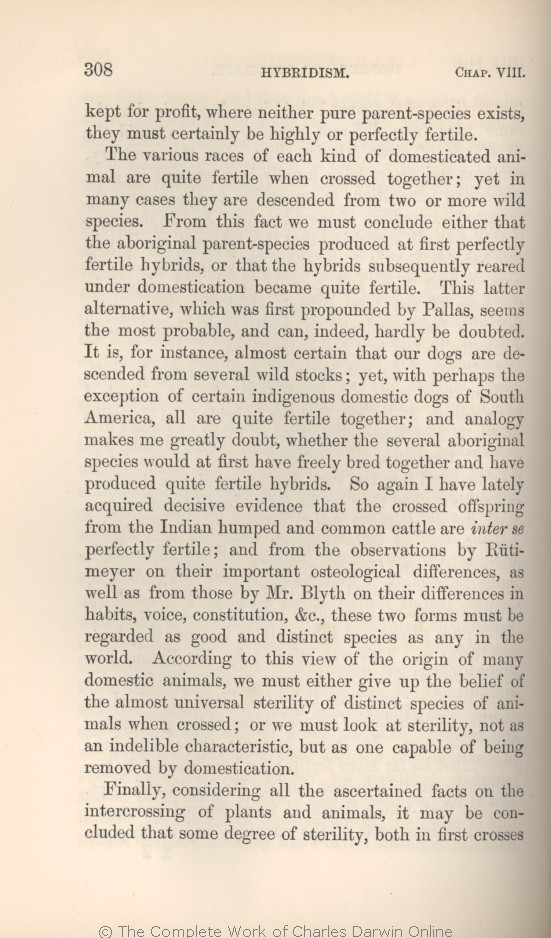The | The 1869 |
| With our domesticated animals, the 1872 |
| of each kind of domesticated animal 1869 |
| when crossed together 1872 |
| fertile 1869 | | fertile; 1872 |
| when crossed together; 1869 |
| OMIT 1872 |
| produced at first 1869 |
| at first produced 1872 |
| 2 blocks not present in 1869 1872; present in 1859 1860 1861 1866 | | A doctrine which originated with Pallas,
has been largely accepted by modern naturalists; namely, that most of our domestic animals have descended from two or more aboriginal
species, since commingled by intercrossing.
On this view, the aboriginal species must either at first have produced quite fertile hybrids, or the hybrids must have become in subsequent generations
quite fertile under domestication.
|
| alternative, 1869 1872 | | alternative 1859 1860 1861 1866 |
| which was first propounded by Pallas, seems 1869 |
| seems to me 1859 1860 |
| seems 1861 1866 |
| which was first propounded by Pallas, seems by far 1872 |
| can, indeed, hardly be doubted. 1869 1872 |
| I am inclined to believe in its truth, although it rests on no direct evidence. 1859 1860 1861 |
| I have hardly any doubt of its truth, although it rests on no direct evidence. 1866 |
| It is, 1866 1869 1872 | | I believe, 1859 1860 1861 |
| almost certain that 1866 1869 1872 |
| that 1859 1860 1861 |
| are 1869 1872 | | have 1859 1860 1861 1866 |
| and 1859 1860 1861 1866 1869 | | but 1872 |
| I have lately acquired decisive evidence that the crossed offspring from the Indian humped and common 1866 1869 1872 |
| there is reason to believe that our European and the humped Indian 1859 1860 1861 |
|
inter se
perfectly fertile; and from the observations by Rütimeyer on their important osteological differences, as well as from those
1866 1869 |
| quite fertile together; but from facts communicated to me 1859 1860 1861 |
|
inter se
perfectly fertile; and from the observations by Rütimeyer on their important osteological differences, as well as from those
1872 |
| Blyth 1866 1869 1872 | | Blyth, 1859 1860 1861 |
| on their differences in habits, voice, constitution, &c., these two forms 1866 1869 1872 |
| I think they 1859 1860 1861 |
| regarded 1866 1869 1872 | | considered 1859 1860 1861 |
| good and distinct species as any in the world. 1869 |
| distinct species. 1859 1860 1861 |
| good and distinct species—as good as any in the world. 1866 |
| good and distinct species. 1872 |
| 1 blocks not present in 1859 1860 1861 1866 1869; present in 1872 | | The same remarks may be extended to the two chief races of the pig.
|
| According to this view 1869 |
| On this view 1859 1860 1861 1866 |
| We must, therefore, either give up the belief 1872 |
| origin of many domestic animals, 1869 |
| origin of many of our domestic animals, 1859 1860 1861 1866 |
| universal sterility of species when crossed; or 1872 |
| either give up the belief of the almost universal sterility of distinct species of animals when crossed; or we must 1859 1860 1861 1866 1869 |
| OMIT 1872 |
| sterility, 1859 1860 1861 1866 1869 |
| this sterility in animals, 1872 |
|









